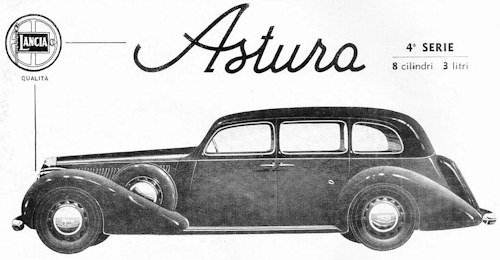Lancia Astura
 |
|
|
Production period: |
1931 to 1939 |
|
Class : |
Luxury car |
|
Body versions : |
Saloon , Coupé ,Cabriolet |
|
Engines: |
Gasoline : 2.6-3.0 liters (53-60 kW) |
|
Length: |
4517-4840 mm |
|
Width: |
1620-1642 mm |
|
Wheelbase : |
3100-3332 mm |
|
Curb weight : |
1060 kg |
The Lancia Astura was an automobile of the manufacturer Lancia , which was produced from 1931 to 1939.
History
The Astura was presented at the Paris Motor Show in 1931. The car was designed to be assembled by external bodybuilders and marked the upper price segment. Motorized was the Astura with a V8 engine. The Astura was produced until 1939, it lasted until the 1950s when the Lancia Aurelia once again produced a top-of-the-range Lancia model.
The previous model Lancia Lambda had been replaced by the cheaper Lancia Artena and the high-priced Astura.
Altogether there were four building series:1st series from 1931 to 1932 in 496 units the 2nd series from 1932 to 1933 in 750 units, changes were better noise reduction. The 3rd series from 1933 to 1937 in 1243 units, in addition with short or long wheelbase and the 4th series from 1937 to 1939 in 423 units, only with long wheelbase.
The Astura, was the third and last of the eight-cylinder Lancias.A later, simpler concept with more commercial aspirations, it really began as a slightly grander alternative for the V4 Artena, but as the years went by (from late '31 until the outbreak of war) it was progressively outstretched and burdened to carry ornate extravagancies like the Pinin Farina convertiblee. After the first two series, in 1934 engine capacity was increased 4000rpm to just under 3-litres.
The fourth and final series, introduced in 1937, financial and engineering resources were applied to a fundamental rethink of its chassis structure, yet total production only just exceeded 2900. Compared with the Dilambda, still made in small numbers through to 1937, the Astura benefited froma smoother and quieter engine resulting from its simpler valve gear and the fact that it rested on four rubber cushions instead of being bolted rigidly to the frame.
Lancia found it necessary to a warning to the instrument panel, encircled by a chromium-plated bezel to match the dials:
IMPORTANT: Owing to the high efficiency and perfect balance of this engine, the driver is inclined, without noticing it, to exceed the safety limit of revolutions and thus risk the lasting qualities of the engine. Avoid, therefore, excess of the following speeds:
ON 1st = 23mph
ON 2nd = 37mph
ON 3rd = 56mph
Under the bonnet concessions to architectural symmetry. So the Astura has no external inlet manifolding, the water pump is concealed within the cylinder block (but arranged to discharge through holes in the timing cover, and each bank has its own rocker cover, four-branch exhaust manifold and water outlet to the radiator.
The Astura head the camshaft bearing bushes were trapped between the top of the iron head and an aluminium casting above that also carried the rocker shafts, the head studs passing through both castings. A downdraught twin-choke Zenith, weighing the earth but equally durable,the aluminium component included twin induction tracts to mate with those incorporated in the iron head.
First and Second Series Astura engines gave 73bhp at 4000rpm from their 2.6-litres — 27.6bhp per litre. This unexceptional specific output was maintained when, in 1934, the capacity was stretched to 2972cc and power rose to 82bhp. Bore and stroke in this form were 74.61 ><85mm, whereas the earlier version had a 69.85mm bore. By comparison, the Dilambda was dimensioned 79.37mm>< 100mm and claimed to give off 100bhp at 3000rpm.
Hydraulic brakes were adopted for the fourth series, in place of a servo-assisted mechanical system involving rods, cables, pulleys and compensator boxes. At the same
time the front suspension was tidied up still further (although invisible under the fashionable deep wings) and made from larger diameter tube, while
the enclosed coil springs were wound from round section stock in place of rectangular.
